 W
WThe Acaridae are a family of mites. Common forms include some mold mites, for example the grain mite. Genera in the family include:
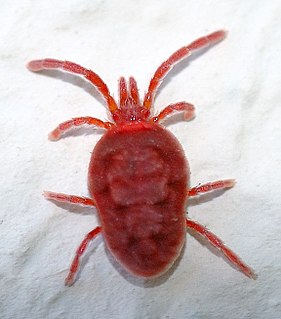 W
WMites are small arachnids.
 W
WMites are small arachnids.
 W
WThe Acaridae are a family of mites. Common forms include some mold mites, for example the grain mite. Genera in the family include:
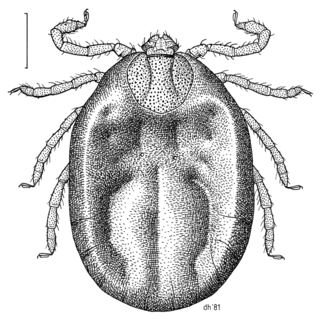 W
WHaemaphysalis longicornis, the Asian longhorned tick, longhorned tick, bush tick, Asian tick, or cattle tick, is a parasitic arachnid belonging to the tick family Ixodidae. The Asian longhorned tick is a known livestock pest, especially in New Zealand, and can transmit a disease called theileriosis to cattle but not to humans. However, the tick has been associated with several other tickborne diseases in humans.
 W
WHaemaphysalis longicornis, the Asian longhorned tick, longhorned tick, bush tick, Asian tick, or cattle tick, is a parasitic arachnid belonging to the tick family Ixodidae. The Asian longhorned tick is a known livestock pest, especially in New Zealand, and can transmit a disease called theileriosis to cattle but not to humans. However, the tick has been associated with several other tickborne diseases in humans.
 W
WCecidophyopsis ribis is an eriophyid mite which is best known for being a plant parasite, a pest of Ribes species, the genus that includes gooseberries and blackcurrants.
 W
WCecidophyopsis ribis is an eriophyid mite which is best known for being a plant parasite, a pest of Ribes species, the genus that includes gooseberries and blackcurrants.
 W
WCecidophyopsis ribis is an eriophyid mite which is best known for being a plant parasite, a pest of Ribes species, the genus that includes gooseberries and blackcurrants.
 W
WCecidophyopsis ribis is an eriophyid mite which is best known for being a plant parasite, a pest of Ribes species, the genus that includes gooseberries and blackcurrants.
 W
WCecidophyopsis ribis is an eriophyid mite which is best known for being a plant parasite, a pest of Ribes species, the genus that includes gooseberries and blackcurrants.
 W
WEriophyes tiliae is a mite that forms the lime nail gall or bugle gall. It develops in a chemically induced gall; an erect, oblique or curved distortion rising up from the upper surface of the leaves of the common lime (linden) tree Tilia × europaea.
 W
WHaemaphysalis longicornis, the Asian longhorned tick, longhorned tick, bush tick, Asian tick, or cattle tick, is a parasitic arachnid belonging to the tick family Ixodidae. The Asian longhorned tick is a known livestock pest, especially in New Zealand, and can transmit a disease called theileriosis to cattle but not to humans. However, the tick has been associated with several other tickborne diseases in humans.
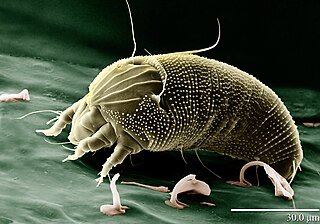 W
WAceria anthocoptes, also known as the russet mite, rust mite, thistle mite or the Canada thistle mite, is a species of mite that belongs to the family Eriophyidae. It was first described by Alfred Nalepa in 1892.
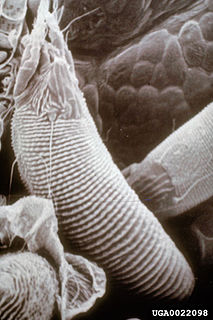 W
WAceria chondrillae is a gall forming deuterogynous, eriophyid (mite) often used as a biological control of the noxious weed, Chondrilla juncea, a highly competitive herbaceous perennial composite found in Europe, Asia, Australia and North America.
 W
WAceria chondrillae is a gall forming deuterogynous, eriophyid (mite) often used as a biological control of the noxious weed, Chondrilla juncea, a highly competitive herbaceous perennial composite found in Europe, Asia, Australia and North America.
 W
WAceria sheldoni, commonly called the citrus bud mite, is a species of mite belonging to the family Eriophyidae. It feeds in leaf- and flower-buds of Citrus spp., causing deformation to leaves, flowers and fruit, and is a worldwide pest of citrus fruit production.
 W
WAceria sheldoni, commonly called the citrus bud mite, is a species of mite belonging to the family Eriophyidae. It feeds in leaf- and flower-buds of Citrus spp., causing deformation to leaves, flowers and fruit, and is a worldwide pest of citrus fruit production.
 W
WHaemaphysalis longicornis, the Asian longhorned tick, longhorned tick, bush tick, Asian tick, or cattle tick, is a parasitic arachnid belonging to the tick family Ixodidae. The Asian longhorned tick is a known livestock pest, especially in New Zealand, and can transmit a disease called theileriosis to cattle but not to humans. However, the tick has been associated with several other tickborne diseases in humans.
 W
WEriophyidae is a family of more than 200 genera of mites, which live as plant parasites, commonly causing galls or other damage to the plant tissues and hence known as gall mites. About 3,600 species have been described, but this is probably less than 10% of the actual number existing in this poorly researched family. They are microscopic mites and are yellow to pinkish white to purplish in color. The mites are worm like, and have only two pairs of legs. Their primary method of population spread is by wind. They affect a wide range of plants, and several are major pest species causing substantial economic damage to crops. Some species, however, are used as biological agents to control weeds and invasive plant species.
 W
WEriophyidae is a family of more than 200 genera of mites, which live as plant parasites, commonly causing galls or other damage to the plant tissues and hence known as gall mites. About 3,600 species have been described, but this is probably less than 10% of the actual number existing in this poorly researched family. They are microscopic mites and are yellow to pinkish white to purplish in color. The mites are worm like, and have only two pairs of legs. Their primary method of population spread is by wind. They affect a wide range of plants, and several are major pest species causing substantial economic damage to crops. Some species, however, are used as biological agents to control weeds and invasive plant species.
 W
WAculops fuchsiae, commonly known as fuchsia gall mite, is a species of mite in the family Eriophyidae. It feeds on Fuchsia plants, causing distortion of growing shoots and flowers. It is regarded as a horticultural pest.
 W
WEriophyidae is a family of more than 200 genera of mites, which live as plant parasites, commonly causing galls or other damage to the plant tissues and hence known as gall mites. About 3,600 species have been described, but this is probably less than 10% of the actual number existing in this poorly researched family. They are microscopic mites and are yellow to pinkish white to purplish in color. The mites are worm like, and have only two pairs of legs. Their primary method of population spread is by wind. They affect a wide range of plants, and several are major pest species causing substantial economic damage to crops. Some species, however, are used as biological agents to control weeds and invasive plant species.
 W
WScutigera coleoptrata, also known as the house centipede, is a species of centipede that is typically yellowish-grey and has up to 15 pairs of long legs. Originating in the Mediterranean region, it has spread to other parts of the world, where it can live in human homes. It is an insectivore; it kills and eats other arthropods, such as insects and arachnids.
 W
WScorpio maurus is a species of North African and Middle Eastern scorpion, also known as the large-clawed scorpion or Israeli gold scorpion.
 W
WEriophyes tiliae is a mite that forms the lime nail gall or bugle gall. It develops in a chemically induced gall; an erect, oblique or curved distortion rising up from the upper surface of the leaves of the common lime (linden) tree Tilia × europaea.
 W
WHaemaphysalis longicornis, the Asian longhorned tick, longhorned tick, bush tick, Asian tick, or cattle tick, is a parasitic arachnid belonging to the tick family Ixodidae. The Asian longhorned tick is a known livestock pest, especially in New Zealand, and can transmit a disease called theileriosis to cattle but not to humans. However, the tick has been associated with several other tickborne diseases in humans.
 W
WHaemaphysalis longicornis, the Asian longhorned tick, longhorned tick, bush tick, Asian tick, or cattle tick, is a parasitic arachnid belonging to the tick family Ixodidae. The Asian longhorned tick is a known livestock pest, especially in New Zealand, and can transmit a disease called theileriosis to cattle but not to humans. However, the tick has been associated with several other tickborne diseases in humans.
 W
WNotoedric mange, also referred to as Feline scabies, is a highly contagious skin infestation caused by an ectoparasitic and skin burrowing mite Notoedres cati. N. cati is primarily a parasite of felids, but it can also infest rodents, lagomorphs, and occasionally also dogs and foxes. This skin disease also has zoonotic potential. Infestation is also called acariasis, which refers to a rash that is caused by mites.
 W
WSteneotarsonemus spinki, the panicle rice mite, spinki mite, or rice tarsonemid mite, is a species of mite in the family Tarsonemidae, the white mites. It is a serious pest of rice in tropical Asia, Central America, and the Caribbean.
 W
WSteneotarsonemus spinki, the panicle rice mite, spinki mite, or rice tarsonemid mite, is a species of mite in the family Tarsonemidae, the white mites. It is a serious pest of rice in tropical Asia, Central America, and the Caribbean.
 W
WSteneotarsonemus spinki, the panicle rice mite, spinki mite, or rice tarsonemid mite, is a species of mite in the family Tarsonemidae, the white mites. It is a serious pest of rice in tropical Asia, Central America, and the Caribbean.
 W
WAceria anthocoptes, also known as the russet mite, rust mite, thistle mite or the Canada thistle mite, is a species of mite that belongs to the family Eriophyidae. It was first described by Alfred Nalepa in 1892.
 W
WAceria anthocoptes, also known as the russet mite, rust mite, thistle mite or the Canada thistle mite, is a species of mite that belongs to the family Eriophyidae. It was first described by Alfred Nalepa in 1892.
 W
WAceria chondrillae is a gall forming deuterogynous, eriophyid (mite) often used as a biological control of the noxious weed, Chondrilla juncea, a highly competitive herbaceous perennial composite found in Europe, Asia, Australia and North America.
 W
WAceria chondrillae is a gall forming deuterogynous, eriophyid (mite) often used as a biological control of the noxious weed, Chondrilla juncea, a highly competitive herbaceous perennial composite found in Europe, Asia, Australia and North America.
 W
WSteneotarsonemus spinki, the panicle rice mite, spinki mite, or rice tarsonemid mite, is a species of mite in the family Tarsonemidae, the white mites. It is a serious pest of rice in tropical Asia, Central America, and the Caribbean.
 W
WOligonychus ununguis, the spruce spider mite, is a globally widespread pest of spruce. Though not particularly important in the forest, it has been bothersome on planted spruce in the Prairie Provinces, and is considered one of the most important pests of spruce plantations in Ontario. As well, ornamental specimens of spruce and most other conifers throughout the range often suffer damage. The pest is barely visible without the aid of a magnifier and is rarely noticed until discoloured foliage is found on an affected tree. To check for the presence of mites, sharply jar suspected foliage over a piece of white paper, and watch for movement of tiny objects. If a red stain appears when the objects are smeared against the paper, the probability is high that spider mites are present.
 W
WAceria anthocoptes, also known as the russet mite, rust mite, thistle mite or the Canada thistle mite, is a species of mite that belongs to the family Eriophyidae. It was first described by Alfred Nalepa in 1892.
 W
WAculops lycopersici, also known as the tomato russet mite, is a species of mite that belongs to the family Eriophydae.
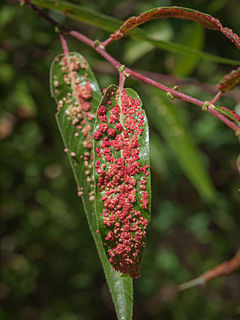 W
WAculops tetanothrix, also known as the willow gall mite, is a species of mite that belongs to the family Eriophydae. The mite is yellow, with brown or sometimes orange.
 W
WAculops tetanothrix, also known as the willow gall mite, is a species of mite that belongs to the family Eriophydae. The mite is yellow, with brown or sometimes orange.
 W
WXystodesmidae is a family of millipedes. Its members often have very small distributional areas, with many species only known from a single locality. They are found across the northern hemisphere, with peak diversity in the Appalachian Mountains, where one-third of the 300 or so species occur. They are particularly abundant in deciduous broadleaf forests in the Mediterranean Basin, Africa, Asia, Central and North America, and Russia. Information on basic taxonomy is scant for this family; for example, it is estimated that the genus Nannaria contains over 200 species, but only 25 have so far been described.
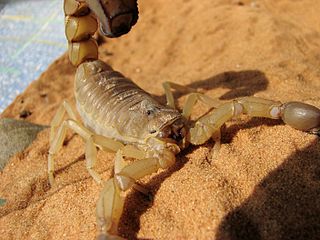 W
WAndroctonus australis is a hardy desert scorpion from North Africa, Somaliland, the Middle East, Pakistan and India. A. australis, along with A. amoreuxi and Pandinus imperator, is the most commonly available scorpions found in the exotic animal trade.
 W
WAndroctonus australis is a hardy desert scorpion from North Africa, Somaliland, the Middle East, Pakistan and India. A. australis, along with A. amoreuxi and Pandinus imperator, is the most commonly available scorpions found in the exotic animal trade.